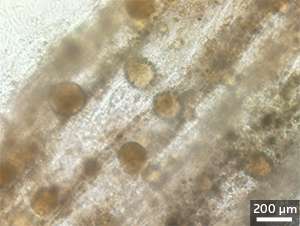A fresh hope for regaining lost hair

Hair loss is usually genetically determined but can also be the result of aging or chronic illness. It is often a distressing condition that negatively affects the self-confidence and social life of the men and women who experience it. Now, researchers at the A*STAR Institute of Bioengineering and Nanotechnology (IBN) have engineered a three-dimensional biological model of a hair follicle that they hope will assist in the discovery of new hair regrowth therapies.
The IBN model relies on a patented microfiber fabrication technology previously developed by the team to generate and then assemble fibers containing multiple skin cells, creating a three-dimensional living structure that mimics the hair follicle—the part of the skin that produces new hair. "Our model mimics the size and cell arrangement of real hair follicles," says Jackie Y. Ying, professor and executive director at IBN, explaining that these factors are important for drug testing.
In the hair follicle, the process of hair growth is regulated by interactions between two main types of cells: epithelial cells, which surround the hair shaft, and dermal papilla cells that are located at the base of the follicle. The IBN model allows these interactions to be closely studied, providing information that researchers believe will be crucial to the development of new treatments for baldness.
The model's second advantage is its transparency, which permits easy visualization of cell interactions. "Existing models require more time and work as their structures are opaque and have to be sliced into thin sections before any analysis can be done," explains Ying. "Our hair structures can be examined immediately under a microscope as they are implanted into ultra-fine and translucent fibers."
The researchers found that the hair follicle cells in their model also activated genes involved in actual hair production. "Our model exhibits similar cell behavior as occurs in real hair follicles," says Andrew Wan, team leader and principal research scientist at IBN. By implanting the model under the skin of mice, the team was able to demonstrate the presence of natural-looking hair follicle structures, indicating that the model could be used to screen candidate compounds that may induce hair formation. At present, there are only two medications approved by the US Food and Drug Administration to treat hair loss, and while these products have been proven to slow the progression of the loss, they are ineffective in promoting new hair growth.
In the next phase of the project, the team plans to screen for drugs that promote hair growth as well as to study the effects of active ingredients in hair and skincare products on the hair follicle. Their findings will be valuable to both the pharmaceutical and consumer care industries, which are looking to develop new products to treat baldness. "Our model allows us to better understand the mechanisms that control the development and growth of hair follicles," notes Ying. "We hope that our invention will lead to a solution for the multitude of people affected by hair loss around the world."

















